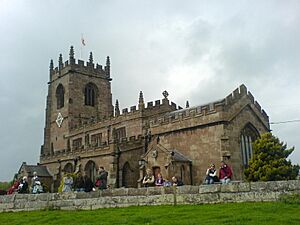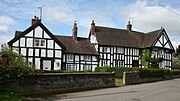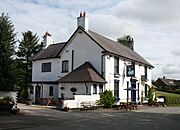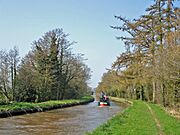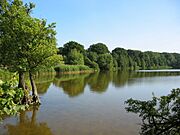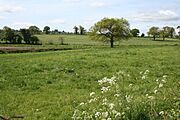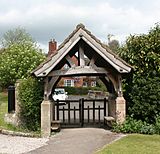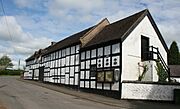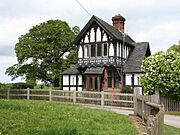Marbury, Cheshire facts for kids
Quick facts for kids Marbury |
|
|---|---|
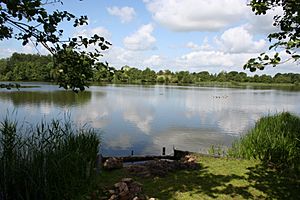 Marbury Big Mere |
|
| Population | 352 (combined with Wirswall, 2011) |
| OS grid reference | SJ560457 |
| Civil parish |
|
| Unitary authority |
|
| Ceremonial county | |
| Region | |
| Country | England |
| Sovereign state | United Kingdom |
| Post town | WHITCHURCH |
| Postcode district | SY13 |
| Dialling code | 01948 |
| EU Parliament | North West England |
| UK Parliament |
|
Marbury is a small village in Cheshire, England. It's part of the civil parish called Marbury and District. The village is about 3 miles (4.8 km) northeast of Whitchurch and 7 miles (11 km) southwest of Nantwich.
Marbury is known for its beautiful countryside and five lakes, called meres. These meres are important places for wildlife. The area is mostly farmland, with dairy farming being the main activity. The Llangollen Canal also runs along the northern edge of the parish. Marbury has a long history, with its church dating back to the 15th century. Every May, the village hosts a fun country fair called "Marbury Merry Days."
Contents
Marbury's Past: A Look at History
Ancient Times in Marbury
Not much is known about Marbury's very early history before the Norman Conquest in 1066. However, some interesting finds tell us people were here a long time ago. A Bronze Age axe, about 3,000 years old, was found near the village. It has a cool trident design!
Roman coins have also been discovered, but there's no sign that Romans actually lived here. Even older, parts of two skulls, from an adult and a child, were found in Marbury Big Mere. They are from around 750 AD. A piece of an old cooking pot from the late Saxon period was also found.
Marbury was mentioned in the Domesday Book in 1086, which was a big survey of England. It was called Merberie back then. The name "Marbury" means "a fortified place near a lake." Even though the name suggests it, there's no evidence of a fort here.
From Medieval Times to the Civil War
In the past, the manor (or land) of Marbury was owned by different families. A wooden church was built here in 1299, on the same spot where the current church stands. This shows how important the church has been to the village for centuries.
During the 15th and 16th centuries, the Earl of Shrewsbury owned the land. In 1551, a sad event happened when 16 people in Marbury died from a sickness, possibly influenza.
The English Civil War happened in the 1640s, a big fight between Parliament and the King. Thomas Marbury, a local landowner, supported Parliament. Because of this, Marbury was affected by the war, with soldiers from both sides taking supplies from the village between 1642 and 1644. After the war, Thomas Marbury and other Parliament supporters were pardoned.
A charity school was started in Marbury churchyard in 1688. It helped educate children in the village for many years.
Marbury's Recent History
In 1758, the Knight family bought the manor of Marbury. Later, the Poole family became very important in the area. They built the grand Marbury Hall around 1805–10. The older Marbury Old Hall was eventually torn down.
Marbury had two pubs in the 1760s: The Leathern Bottle and The Swan. The Leathern Bottle closed, but The Swan was rebuilt around 1884 and is still open today! The village school moved in 1825 and a new one opened in 1871.
In the 1800s, cheesemaking was a big deal in Marbury, just like in many parts of South Cheshire. New canals and railways helped farmers send their cheese and milk to big cities like London and Liverpool. Most people in Marbury worked in farming back then.
Writers from the early 1900s described Marbury as a beautiful, quiet place with wooded hills, lovely lanes, and meres. It sounds like a peaceful escape!
During the First World War, 86 men from Marbury served. After the war, the village started getting modern services. A telephone exchange was built in 1927, electricity came after 1930, and the first bus service started in 1934. A village hall was built in 1929, and piped water arrived around 1930.
In the Second World War, children who had to leave their homes in cities were housed at Marbury Hall. After the war, more houses were built in the village. Marbury School closed in 1988 because there weren't enough students. Many local businesses also closed down. However, the canal, which used to carry goods, became popular for fun activities like boating.
How Marbury is Governed
Marbury and District is looked after by the Marbury & District Parish Council. This council works together with the nearby villages of Norbury and Wirswall. The local government for the wider area is Cheshire East. Marbury is part of the Eddisbury area for the UK Parliament.
Marbury's Landscape and Economy
The Marbury area covers about 2,168 acres (877 hectares). The land is gently rolling, going from about 75 meters (246 feet) high near the Llangollen Canal to about 120 meters (394 feet) in the southeast.
There are five main lakes, or meres, in the area: Marbury Big Mere and Little Mere, Quoisley Big Mere and Little Mere, and part of Brankelow Moss. Marbury Big Mere is the largest, about 500 meters (1,640 feet) long. These meres were formed by glaciers thousands of years ago, when huge chunks of ice melted and left behind hollows that filled with water.
The Llangollen Canal runs along the northern and western edges of the parish. Several bridges cross the canal, including the old Church Bridge, which is made of red sandstone and dates from the late 1700s or early 1800s.
Marbury is mostly a rural area, meaning it's countryside. The main activity is farming, especially dairy farming. Tourism is also important, with people enjoying walking, cycling, fishing, and boating on the canal.
Marbury village itself is a conservation area, which means its special character and history are protected.
Wildlife and Nature in Marbury

The Marbury and Quoisley Meres are amazing places for wildlife, especially with their surrounding reed beds. Quoisley Meres are so important that they are a Site of Special Scientific Interest and a Wetland of International Importance!
These meres are home to many types of wildfowl (water birds), including gadwall, garganey, and different kinds of grebes. You might also spot bitterns, Canada geese, and mute swans. The woodlands around the parish also have lots of birds, like nightingales.
Quoisley Meres are also important for tiny water creatures (invertebrates) and have over a hundred different plant species, some of which are rare in Cheshire. Marbury Big Mere is a private fishing lake. Anglers can catch fish like roach, perch, pike, tench, bream, and different types of carp.
Marbury's Population
The population of Marbury has changed over time. In 1801, there were 372 people. By 2001, the population was 244 people living in 103 homes. In 2011, when combined with Wirswall, the population was 352.
Places to Worship in Marbury
The main church in Marbury is St Michael and All Angels. It's an Anglican church built with red sandstone in the 15th century. It's a very old and important building. The church tower leans a bit, about 25 inches (64 cm) off straight!
Inside the church, you can see an octagonal (eight-sided) wooden pulpit that is as old as the church itself. It's the oldest wooden pulpit in Cheshire! The churchyard wall and the lychgate (a covered gate at the entrance to the churchyard) are also very old and important. The lychgate was built around 1919 to remember those who died in the First World War.
Other Interesting Places in Marbury
Around Marbury Village
In the center of Marbury village, there's a lovely village green with a big oak tree. This tree was planted around 1814. Marbury Little Mere is next to the green, and Big Mere is nearby.
The Swan pub, a popular country pub, overlooks the green. It was first built in 1765 but rebuilt around 1884. The center of Marbury village is a conservation area, meaning its special character is protected. Marbury has also won awards in "Best Kept Village" competitions!
You can see some beautiful old timber-framed, black-and-white buildings in the village. Marbury Cottage, from the late 1500s or early 1600s, is thought to have been a dower house (a house for a widow). The 1–4 Black and White Cottages, also from the same period, were once one big house. There's also a 17th-century outhouse near The Swan pub.
Marbury Hall
Marbury Hall is a beautiful white brick hall built around 1805–10. It sits on a hill overlooking Marbury Big Mere. It was built for the Poole family. Next to the hall is an even older timber-framed farmhouse from the 17th century.
The gatelodge (a small house at the entrance to the hall's driveway) is also very pretty. It was built in 1876 and has cool decorative timber framing.
Other Notable Spots
Hadley Hall, another timber-framed farmhouse with red brick, dates back to the 16th century.

You can also find a tall sandstone obelisk (a tall, four-sided pillar) on a hill near the Combermere estate. It's about 20 meters (66 feet) high and was built in 1890 to remember Stapleton Cotton, a famous military leader. He fought in important wars and took the fort of Bharatpur in India.
Getting Around Marbury
Marbury has a network of small, winding country roads. Wirswall Road, Hollins Lane, and Wrenbury Road are some of the main ones connecting the village to nearby areas. The A49 main road runs near the western edge of the parish.
The Welsh Marches railway line also goes through Marbury. The closest train stations are in Wrenbury and Whitchurch. If you like cycling, National Cycle Network routes 45 and 70 pass through Marbury. The South Cheshire Way, a long-distance walking path, also crosses the parish.
Learning in Marbury
Since the Marbury-Cum-Quoisley Church of England School closed in 1988, there are no schools directly in the parish. Children from Marbury usually go to Wrenbury Primary School and Brine Leas High School in Nantwich.
Marbury Merry Days: A Fun Fair!
"Marbury Merry Days" is a traditional country fair held every year, usually in May, right next to Marbury Big Mere. It lasts for two days, and all the money raised goes to help maintain the church.
The fair started in 1978 to raise money for church repairs. It's very popular and raises a lot of money each year! At the fair, you can see all sorts of cool things like old farm machines, vintage cars, and model airplanes. There are also historical reenactments, puppet shows, and fun races. It's a great event for the whole family!
|



